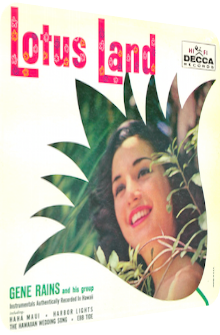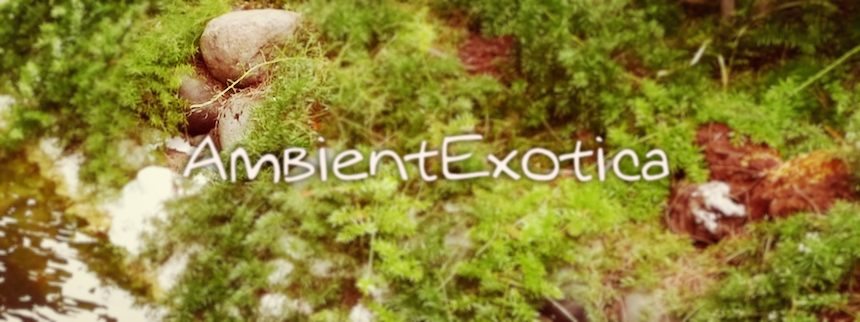
Gene Rains
Lotus Land
1960
Sometimes, life is unfair. We all know a relative, close friend, colleague or artist whose genius isn't realized by the public, even though he or she accomplished various things, brings us in a good mood or delivers works of art that move us so much that we cannot live on without them. Vibraphonist Gene Rains is such a figure for Exotica lovers. Normally he should be mentioned without hesitation in every sentence that mentions the Exotica trio Martin Denny, Arthur Lyman and Les Baxter, as his tropical sounds and successful adaptations are at least as vivid and wanderlust-evoking as the other guys' music outputs. Nowadays his 3 albums have gained the status as classic examples of perfect Exotica music – unfortunately, this status hasn't reached the ears of the respective copyright holders yet, as you won't find this beautiful music on CD, let alone as digital download on iTunes.
Back then, the music of Rains was buried among many other releases and remained largely unknown, even though his group performed regularly and successfully at various venues and hotels to great applause. Which factor denied Rains a bigger success? Nobody is quite sure. Lots of books have been written about the public sphere and pop culture – why artists become superstars, why certain songs are suddenly considered as milestones while other works of sheer brilliance remain in the shadows of a knowledgeable but exclusive circle. While this discourse is highly interesting,
I'll leave it behind for now and concentrate on the music of Lotus Land, Rains' debut album which was released in 1960 and recorded directly in Hawaii – a unique selling point at the time which was only shared with Arthur Lyman‘s recordings from the Henry J. Kaiser Aluminum Dome in Honolulu. Gene Rains plays the vibes, Paul Conrad is on the piano, flutist Archie Grant is additionally playing the bass and Alan Watanabe plays exotic percussion. Most of the 12 Hawaiian, Faux-Polynesian and American classics are discussed in the next paragraphs.
The Gene Rains Group opens the album with an interpretation of Sammy Fain's Love Is A Many-Splendored Thing, the iconic melody of the 1955 oscar-winning movie with the same name, starring William Holden and Jennifer Jones. The band captures the Asian flavor with shattering cymbals and Chinese gongs, galloping percussion, distinct piano and vibe notes. The Asian flavor is a bit smoothened one minute into the song but the cascading piano notes remain in the background and the ubiquitous cymbals are reminders of the setting as well. I acknowledge the ambitious approach and the vividness, but the percussion is a bit too clarion for my likings and the melodies are hard to grasp; however, there's not even a glint of a cliché, and Conrad and Rains both succeed in blending orchestral and jazzy structures with their main instruments.
Hana Maui is an original composition and resurrects the faux-Polynesian spirits for the first time on the album. Imitated steamer horns or train signals mark the beginning, and the percussion is much more upbeat and dominant while the piano and the xylophone remain in the background until the main melody on the vibes sets in – an interesting concept. Hectical maracas and exotic drums accompany the vibraphone while the melody remains strangely indecisive, oscillating between mystery and joyfulness. Next is the 1937 classic Harbor Lights composed by Hugh Williams. The beginning is utterly dreamy and mixes a long field recording of seagulls with dynamic cymbals. Rains mimics the style of Arthur Lyman on this most accessible song of the whole album by playing the reverberating vibes gently. The gorgeously relaxed ending is also worth mentioning: the polyphonous reverb is sustained for several seconds. A beautiful song!
Lotus Land is yet another magnificent and very exotic song with fake bird calls, a focus on vibes and quietly cascading piano backings by Paul Conrad which are surprisingly echoey. I like Warren Barker's version from 1958 a tiny bit better as it is more soothing and comforting, but this is a personal preference. Rains' version, at the end of the day, has two positive attributes, and that's both the bird calls and the bubbling percussion that mimics a gurgling river. Africa continues the thread of Lotus Land and presents a rich jungle vista with even more animal sounds, marked bongos and Grant's quavering flute that is underlined by dynamic piano backings, exhilarant maracas and pristine tambourines. A tempo shift occurs later that resembles a tribal ritual – a common ingredient in many Exotica albums, but a welcome addition nonetheless due to the especially eclectic nature of the multiple drum layers. A huge favorite of mine. Once you decipher the flute melody and know its turns and twists, the song grows even larger.
Side 2 starts with The Hawaiian Wedding Song written in 1926 by Charles King. The vibes are incisively bright, and while the melody is easy to catch, the piano backings by Conrad are quite complex and even slightly cacophonous. This is nevertheless a weaker piece, I‘m afraid. The ending features the awesome sustain of euphonious vibe layers, but the vibe melody, while being perfectly exotic, is too jumpy and complex, even though King's original is successfully charming. I am of the opinion that the substitution of the voice with vibes didn't work all too well here, though it's a common practice in the Exotica realm.
Dahil Sa Iyo is the rather stripped down adaptation of a real Philippine love song with euphoniously glistening vibes, another galloping percussion and marimba backings. I like this version quite much, as Rains never succumbs to overly gimmicky additions but focuses on the soothing setup of a dreamy song, and it‘s the marimba that is the most charming instrument. Danse Arabe is the mesmerizing version of Tchaikovsky's signature track off his Nutcracker Suite. The group accomplishes an entanglement of smoothened percussive bits and slightly dangerous counterparts without leaving the soothing Exotica setting. Rains' vibraphones are particularly strong and are put right to the forefront of the recording. While every other instrument remains in the background, this is no weakness in the end, but a welcoming peculiarity of this rendition. Even the percussion is in the background this time and looses much of its sharpness and vividness due to this fact, making room for the vibraphone to shine.
Ebb Tide is an interpretation of the 1953 tune by Carl Sigman and Robert Maxwell, and a very good one it is too. Conrad's cascading piano notes, the re-introduction of the seagull recording and the toned down vibe notes offer an exquisitely comforting vista which is enhanced by Watanabe's smooth maracas. This is also the most jazzy tune on the album whose sparkling vibes and the permanent cries of the seagulls make this a successful transformation of a Jazz classic into an Exotica number – yes, field recordings can be gimmicky and deflecting from the music, but on Ebb Tide the gulls‘ screams enhance the smoothness of the reverie.
The final piece is The Naked Sea and an original composition by the band. It begins with playful vibraphone sprinkles, monotonous bass entourages and piano backings in major. The song meanders in different directions and it is hard for the listener to grasp a particular detail and remember it even a few seconds later. However, what is presented is soothing and ambitious, and I for one am glad that the band doesn't come up with deliberately complex or tricky sections. Here, it is all about the interplay and the coherent setting, and while it is hard to remember particular details, everything feels very harmonious. You have to concentrate a bit to uncover the different layers, a work which is not often necessary in supposed Easy Listening albums. A great ending of a special Exotica album.
It is useless and rather naughty to even ponder about a possible explanation in terms of the oversight of the Gene Rains Group by contemporary listeners of the 60's. However, if I had to guess and make a decision in seconds, I would say that the ambitious melodies and the complex interplay between the band members were a bit too heavy for the Easy Listening crowd back then. Please don't get me wrong: I don't question the taste or the intelligence of the listeners, but the style of the group is often times strikingly similar to the third-stream movement of the early 50's, a genre that alienated a huge crowd with its experimental sequences of tones and the oscillation between classical and jazzy styles plus exotic settings.
The polyphony and sheer beauty of Les Baxter's string orchestra is much more inviting and impressive on the very first listen than quickly cascading vibes and staccato cymbals. While Rains is successful in transporting the idea of exotic vistas in his music, be aware that this is no Lounge music and thus cannot be used as background music – it rather demands the full attention of the listener who, in an ideal world, already has some kind of Jazz knowledge as well as a childlike enthusiasm for paradisian sequences and lush aural landscapes.
If this is a given, the album literally lays wide open in front of the listener and discloses a new part of its secret layers and hidden structures after each listening session. Lotus Land and the remaining two albums by the Gene Rains Group – Far Across The Sea (1961) and Rains In The Tropics (1962) – are not incredibly hard to enjoy… but they contain without a doubt the most interlaced Exotica music of the 60's, with their beautiful melodies being encapsulated in and behind eclectic patterns. Recommended to somewhat skilled listeners. Even though it's the Exotica genre I'm talking about, don‘t be fooled by the front artwork and track titles: you must not put this album away after a first listening session, but need to come back time and again, or otherwise it will not click immediately in its entirety.
Exotica Review 037: Gene Rains – Lotus Land (1960). Originally published on Feb. 18, 2012 at AmbientExotica.com.
